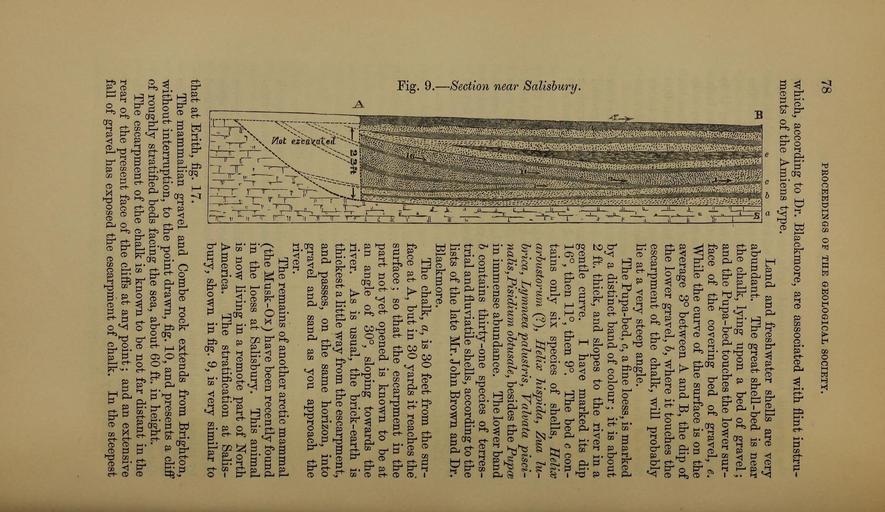MAKE A MEME
View Large Image

| View Original: | The_Quarterly_journal_of_the_Geological_Society_of_London_(12961035625).jpg (2048x1185) | |||
| Download: | Original | Medium | Small | Thumb |
| Courtesy of: | commons.wikimedia.org | More Like This | ||
| Keywords: The Quarterly journal of the Geological Society of London (12961035625).jpg 78 <br> PKOCEEDINGS OF THE GEOLOGICAL SOCIETY <br> which according to Dr Blackmore are associated with flint instru- <br> ments of the Amiens type <br> Land and freshwater shells are very- <br> abundant The great shell-bed is near <br> the chalk lying upon a bed of gravel ; <br> and the Pupa-bed touches the lower sur- <br> face of the covering bed of gravel e <br> While the curve of the surface is on the <br> average 3° between A and B the dip of <br> the lower gravel 6 where it touches the <br> escarpment of the chalk will probably <br> lie at a very steep angle <br> The Pupa-bed c a fine loess is marked <br> by a distinct band of colour ; it is about <br> 2 ft thick and slopes to the river in a <br> gentle curve I have marked its dip <br> 16° then 11° then 9° The bed c con- <br> tains only six species of shells Helix <br> arhustorum Helix hispida Zua lu~ <br> brica Lymnoea palustris Yalvata pisci- <br> nalis Pisidium obtusale besides the Pupce <br> in immense abundance The lower band <br> h contains thirty-one species of terres- <br> trial and fluviatile shells according to the <br> lists of the late Mr John Brown and Dr <br> Blackmore <br> The chalk a is 30 feet from the sur- <br> face at A but in 30 yards it reaches the <br> surface ; so that the escarpment in the <br> part not yet opened is known to be at <br> an angle of 30° sloping towards the <br> river As is usual the brick- earth is <br> thickest a little way from the escarpment <br> and passes on the same horizon into <br> gravel and sand as you approach the <br> river <br> The remains of another arctic mammal <br> the Musk-Ox have been recently found <br> in the loess at Salisbury This animal <br> is now living in a remote part of North <br> America The stratification at Salis- <br> bury shown in fig 9 is very similar to <br> that at Erith fig 17 <br> The mammalian gravel and Combe rock extends from Brighton <br> without interruption to the point drawn fig 10 and presents a clifi <br> of roughly stratified beds facing the sea about 60 ft in height <br> The escarpment of the chalk is known to be not far distant in the <br> rear of the present face of the cliffs at any point ; and an extensive <br> fall of gravel has exposed the escarpment of chalk In the steepest 36102923 111288 51125 Page 78 Text v 25 http //www biodiversitylibrary org/page/36102923 1869 Geological Society of London NameFound Combe NameConfirmed COMBE EOLID 12397 NameBankID 4122786 NameFound Lymnoea palustris NameConfirmed Lemna palustris Haenke ex Mert W D J Koch EOLID 1142162 NameFound Pisidium obtusale NameConfirmed Pisidium obtusale EOLID 4762510 NameBankID 6475394 NameFound Zua NameConfirmed ZuA NameBankID 4386701 Biodiversity Heritage Library The Quarterly journal of the Geological Society of London v 25 1869 Geology Periodicals Smithsonian Libraries bhl page 36102923 dc identifier http //biodiversitylibrary org/page/36102923 smithsonian libraries Information field Flickr posted date ISOdate 2014-03-06 Check categories 2015 August 26 CC-BY-2 0 BioDivLibrary https //flickr com/photos/61021753 N02/12961035625 2015-08-26 15 52 15 cc-by-2 0 PD-old-70-1923 The Quarterly journal of the Geological Society of London 1869 Photos uploaded from Flickr by Fæ using a script | ||||